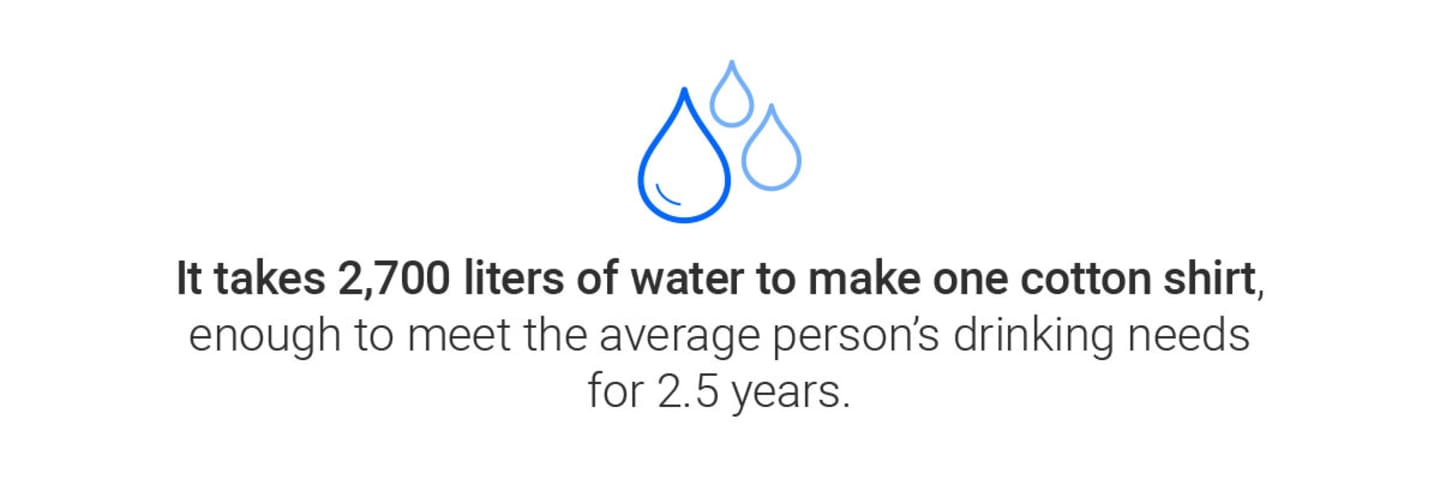Fast Fashion and Sustainability—It’s Not a Good Look
Trendy clothes at low prices can be tempting, but consumers may not realize the harmful side of fast fashion.

Key Takeaways
Fast fashion brands offer affordable, trendy clothing, but we think the industry’s environmental impacts are an unattractive trade-off.
The fast fashion industry has a history of underpaying workers in developing countries and the U.S.
Some governments and industry groups are taking action to help address fast fashion’s negative environmental and societal impacts.
Fast fashion allows consumers to buy clothing styles inspired by fashion show runways or worn by celebrities at affordable, often extremely low, prices (think Zara, H&M Group and Uniqlo, and newcomers Shein and Temu). Unfortunately, these bargains may not be as appealing as they may seem. Fast fashion has been criticized (justifiably, in our view) for its adverse impacts on workers and the environment.
Fast Fashion: Appealing but Problematic
Fast fashion, which appeared in the 1980s, refers to a business model that imitates high-fashion clothing designs, mass-produces them at a low cost and updates store inventories quickly. New technologies have made it possible to dramatically reduce the time required to design an item of clothing, produce it in bulk, and get it into stores. For example, in an episode of a popular British reality TV show, “Breaking Fashion,” UK-based fashion company In the Style reproduced a bodysuit worn by a celebrity and had it available for sale within 10 days.
Fashions go in and out of favor quickly, and because fast fashion retailers’ prices are low, consumers don’t have to think about whether the clothes they buy will last. Most are only worn a few times before they are thrown out. This combination of pressure to produce garments quickly at a low cost, the environmental harms involved in making fabric, and the waste generated when so much clothing ends up in a landfill means fast fashion is far from a bargain.
Fast Fashion’s Damaging Environmental Impacts
There’s no getting around it — the fast fashion industry is environmentally destructive. As a major source of industrial pollution, it produces more greenhouse gases than the aviation industry,1 generates a huge amount of waste and is the second largest consumer of water after agriculture.2
The World Bank estimates the industry is responsible for nearly 20% of all industrial pollution annually.3



One reason fast fashion creates so much environmental damage is that many consumers consider this clothing disposable. An estimated one-half of fast-fashion clothing is discarded in less than a year.4 In addition, an estimated 11.3 million tons of textile waste end up in U.S. landfills yearly, equal to roughly 81.5 pounds per person.5 Discarded clothing made of non-biodegradable fabrics can sit in landfills for up to 200 years.6 And of the more than 100 billion items of clothing produced annually, nearly 20% is never sold and eventually buried, shredded or burned.7
Manufacturing apparel is also resource- and emissions-intensive. Making a single pair of jeans generates as much greenhouse gas as driving a car over 80 miles.8 It takes 2,700 liters of water to make one cotton shirt, enough to meet the average person’s drinking needs for 2.5 years.9 Fashion also depends on and can affect biodiversity, a connection we will explore in a future article.
For Garment Workers, Poor Working Conditions and Low Pay
Fast fashion must be made inexpensively so that retailers can sell at low prices and still make a profit. Not surprisingly, the apparel industry is often associated with poor working conditions, paying workers less than a living wage and using child labor. Bangladesh has an alarming track record:
According to the International Labor Rights Forum, between 2006 and 2012, over 500 apparel workers died in factory fires in Bangladesh, including at least 117 workers in the 2012 Tazreen factory fire (where exits were locked).
In 2013, some 1,134 workers died in the Rana Plaza building collapse, and only one of eight factories in Bangladesh passed recent inspections under the Accord on Fire and Building Safety.10
Bangladeshi garment workers, primarily women, earn roughly $96 a month, while the country’s government wage board suggests a worker needs 3.5 times that amount to live a “decent life with basic facilities.”11
In 2016, a U.S. Department of Labor (DOL) investigation found that 85% of garment factories in Los Angeles violated federal minimum wage regulations, with the average worker paid just $5 to $6 per hour.12 The investigation also found that contractors received only 73% of what they needed to pay workers the minimum wage.13
A 2018 DOL report found evidence of forced and child labor in the garment industries in Argentina, Bangladesh, Brazil, China, India, Indonesia, the Philippines, Turkey and Vietnam, and their supply chains.14 In some countries, cotton growers hire children to pollinate cotton plants by hand. This typically involves regular pesticide exposure and working long hours for pay below the minimum wage.
A Centre for Research on Multinational Corporations (SOMO) report determined that 60% of workers at the yarn and spinning mills it investigated in India were younger than 18 when they started working in these facilities, some as young as 15.15
Making a single pair of jeans produces as much greenhouse gas as driving a car over 80 miles.
Seeking to Reduce Fast Fashion’s Negative Impact
While the environmental harms caused by excessive consumption, which fast fashion promotes, are significant, the industry is making some effort to address them. In a trailblazing move, New York lawmakers introduced the Fashion Sustainability and Social Accountability Act (S.7428) in 2021. New York will become the first state to hold major fashion brands accountable for their environmental practices if the law passes.
Key provisions of the legislation would require apparel companies to:
Document the source of every material, process and shipment involved in bringing goods to market for at least 50% of their suppliers (by volume).
Identify adverse impacts from their greenhouse gas emissions and water and chemical use.
Set targets to reduce carbon emissions and energy consumption across their supply chains.
Disclose the quantity and type of materials their suppliers produce and the volume of recycled materials used annually.16
Outside the U.S., the EU is implementing new reporting and governance directives that cover environmental issues and working conditions across the fashion industry supply chain. France passed a law requiring garments and textiles to carry a “carbon label” informing consumers of the environmental impact of these products. In contrast, Germany’s “green button” certification program requires clothing and textile companies to meet at least 26 social and environmental standards to display the label.17
We believe regulators should establish more stringent labor and environmental standards for fashion industry suppliers.
We see an opportunity for fashion brands that support better working conditions and find ways to reduce waste to meaningfully increase market share and customer loyalty.
What can companies and consumers do to change the fashion industry?
In addition to supporting legislation to address harmful practices, companies and consumers can promote change. For example, the Sustainable Apparel Coalition has created an index that measures the full life-cycle impact of clothing and footwear products. This information can be used to design more easily reused or recycled garments.
The H&M Foundation, in collaboration with the Hong Kong Research Institute of Textiles and Apparel, created a garment-to-garment recycling machine that shreds old garments and converts them into new ones.18 Consumers can support the development of other mechanical and safe chemical recycling technologies.
Companies can invest in developing new fibers and technologies that reduce the environmental effects of production and garment-making. Several have already implemented circular business models to make their products more easily repaired or reused:
The Restory uses technology to repair footwear and handbags from luxury brands, helping these firms to develop circular business models.
The Cocoon Club, a membership subscription for luxury handbags, is building a similar circular solution.
Reflaunt is a fashion technology company that connects brands with the secondary market. It allows customers to resell gently worn apparel via the brands’ websites.19
In our view, all apparel companies should encourage consumers to care for clothes in low-impact ways, such as washing garments in cold water and drying at a lower heat.
To support better conditions for apparel workers, over 120 brands have committed to following the Fair Wear Foundation’s Code of Labor Practices, which forbids child labor and mandates safe and healthy working conditions. Participating companies must regularly audit their suppliers to ensure compliance with these standards.
Brand representatives watch for signs that a factory is subcontracting. For example, if its output exceeds what its workers could produce, it may be using subcontractors, which would raise questions about adherence to the standards.20
Beware of Greenwashing
Unfortunately, it’s not uncommon for fashion companies to market their products as environmentally friendly without delivering on those claims.
For example, Zara announced plans to switch to 100% renewable energy to run its internal operations by 2030 and to reduce and offset all emissions by 2040. It also pledged to use only sustainable, recyclable cotton and polyester materials. However, the company has neither demonstrated transparency about its progress nor mentioned any efforts to lower the massive carbon footprint of its supply chains.21
In addition, we encourage companies to make supply chains transparent so consumers can make informed choices when buying all types of apparel — not just fast fashion. The software company EVRYTHNG and packaging maker Avery Dennison have launched an effort to tag clothing so that consumers can trace an item's production process along a supply chain.22
Consumers will play a pivotal role in creating change in the fashion industry and holding fast-fashion brands accountable for their environmental and social impacts. Bringing sustainability to the forefront of shoppers’ minds is a good place to start.
Authors
Senior Sustainable Research Analyst
Sustainability: It’s in Our Genes®
Sustainability isn't just something we practice; it is part of who we are as a company and as global citizens.
Natural Resources Defense Council, “New York Exposing the Fashion Industry for What it Is: A Climate Nightmare,” accessed May 2024.
Vanessa Turk, “Fast Fashion: Polluting Our Water Millions of Clothing Items at a Time,” GW Environmental and Energy Law Blog, October 2, 2023.
Thomas, “The High Price.”
Ellen McArthur Foundation, “A New Textiles Economy: Redesigning Fashion’s Future,” accessed April 15, 2022.
State of Matter, “10 Scary Statistics About Fast Fashion & the Environment”, accessed May 2024.
Thomas, “The High Price.”
Thomas, “The High Price.”
Reichart and Drew, “By the Numbers.”
Reichart and Drew, “By the Numbers.”
Dana Thomas, “The High Price of Fast Fashion,” Wall Street Journal, August 29, 2019.
Elizabeth Reichart and Deborah Drew, “By the Numbers: The Economic, Social and Environmental Impacts of Fast Fashion,” World Resources Institute, January 10, 2019.
Syama Meagher, “The Not-So-Hidden Ethical Cost of Fast Fashion: Sneaky Sweatshops in Our Own Backyard,” Forbes, February 5, 2020.
“Drop That Sweatshop Pledge,” Garment Worker Center.org, accessed April 15, 2022.
Reichart and Drew, “By the Numbers.”
Josephine Moulds, “Child labor in the fashion supply chain,” Guardian Special Section Sponsored by Unicef, accessed April 15, 2022.
Anushka Challawala, et al., “Sustainable Fashion: New York Considers First Fashion Sustainability Law,” Barclays Research, 2022.
Melissa Gamble, “Is the Tide Changing for the Fashion Industry When It Comes to Regulations?” The Fashion Law, January 4, 2022.
Adele Peters, “Bring your old clothes and this in-store recycling machine will turn them into something new,” Fast Company, May 4, 2021.
Challawala, et al., “Sustainable Fashion.”
Moulds, “Child labor.”
Martina Igini, “Five Fast Fashion Brands Called Out for Greenwashing,” Earth.org, accessed April 24, 2024.
Nathalie Remy, Eveline Spearman, and Steven Swartz, “Style that’s sustainable: A new fast-fashion formula,” McKinsey & Co., October 2016.
Sustainability focuses on meeting the needs of the present without compromising the ability of future generations to meet their needs. There are many different approaches to Sustainability, with motives varying from positive societal impact, to wanting to achieve competitive financial results, or both. Methods of sustainable investing include active share ownership, integration of ESG factors, thematic investing, impact investing and exclusion among others.
References to specific securities are for illustrative purposes only and are not intended as recommendations to purchase or sell securities. Opinions and estimates offered constitute our judgment and, along with other portfolio data, are subject to change without notice.
The opinions expressed are those of American Century Investments (or the portfolio manager) and are no guarantee of the future performance of any American Century Investments portfolio. This material has been prepared for educational purposes only. It is not intended to provide, and should not be relied upon for, investment, accounting, legal or tax advice.